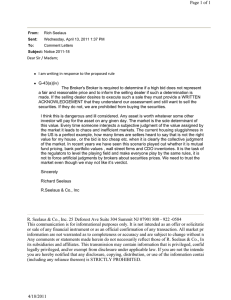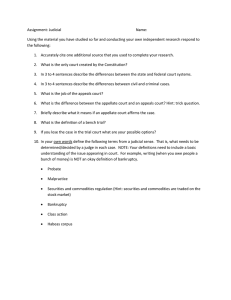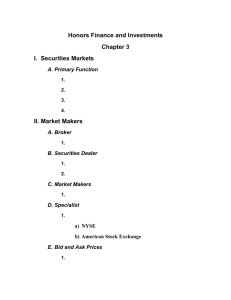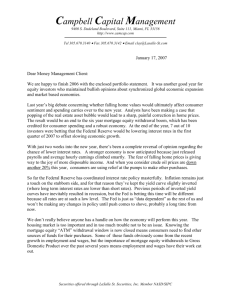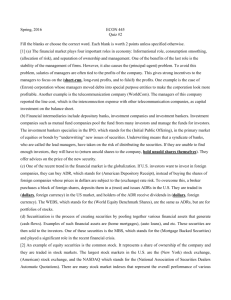Financial Services Alert Key Insolvency Issues for Broker-Dealers,
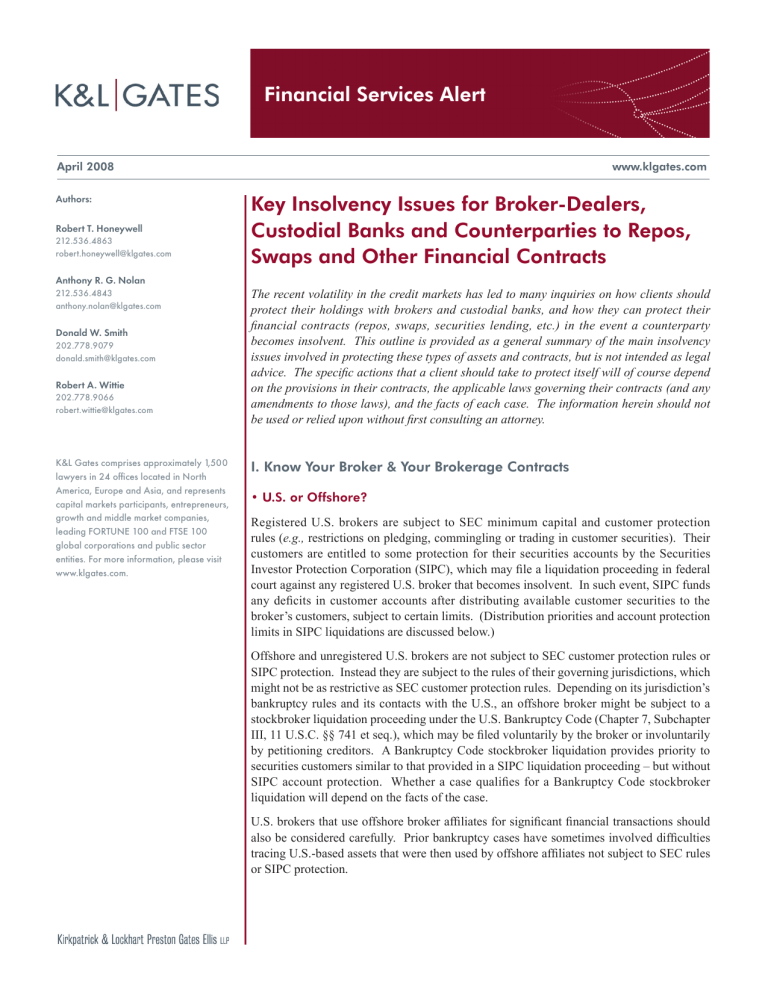
Financial Services Alert
April 2008
Authors:
Robert T. Honeywell
212.536.4863 robert.honeywell@klgates.com
Anthony R. G. Nolan
212.536.4843
anthony.nolan@klgates.com
Donald W. Smith
202.778.9079 donald.smith@klgates.com
Robert A. Wittie
202.778.9066
robert.wittie@klgates.com
K&L Gates comprises approximately 1,500 lawyers in 24 offices located in North
America, Europe and Asia, and represents capital markets participants, entrepreneurs, growth and middle market companies, leading FORTUNE 100 and FTSE 100 global corporations and public sector entities. For more information, please visit www.klgates.com. www.klgates.com
Key Insolvency Issues for Broker-Dealers,
Custodial Banks and Counterparties to Repos,
Swaps and Other Financial Contracts
The recent volatility in the credit markets has led to many inquiries on how clients should protect their holdings with brokers and custodial banks, and how they can protect their financial contracts (repos, swaps, securities lending, etc.) in the event a counterparty becomes insolvent. This outline is provided as a general summary of the main insolvency issues involved in protecting these types of assets and contracts, but is not intended as legal advice. The specific actions that a client should take to protect itself will of course depend on the provisions in their contracts, the applicable laws governing their contracts (and any amendments to those laws), and the facts of each case. The information herein should not be used or relied upon without first consulting an attorney.
I. Know Your Broker & Your Brokerage Contracts
• U.S. or Offshore?
Registered U.S. brokers are subject to SEC minimum capital and customer protection rules ( e.g., restrictions on pledging, commingling or trading in customer securities). Their customers are entitled to some protection for their securities accounts by the Securities
Investor Protection Corporation (SIPC), which may file a liquidation proceeding in federal court against any registered U.S. broker that becomes insolvent. In such event, SIPC funds any deficits in customer accounts after distributing available customer securities to the broker’s customers, subject to certain limits. (Distribution priorities and account protection limits in SIPC liquidations are discussed below.)
Offshore and unregistered U.S. brokers are not subject to SEC customer protection rules or
SIPC protection. Instead they are subject to the rules of their governing jurisdictions, which might not be as restrictive as SEC customer protection rules. Depending on its jurisdiction’s bankruptcy rules and its contacts with the U.S., an offshore broker might be subject to a stockbroker liquidation proceeding under the U.S. Bankruptcy Code (Chapter 7, Subchapter
III, 11 U.S.C. §§ 741 et seq.), which may be filed voluntarily by the broker or involuntarily by petitioning creditors. A Bankruptcy Code stockbroker liquidation provides priority to securities customers similar to that provided in a SIPC liquidation proceeding – but without
SIPC account protection. Whether a case qualifies for a Bankruptcy Code stockbroker liquidation will depend on the facts of the case.
U.S. brokers that use offshore broker affiliates for significant financial transactions should also be considered carefully. Prior bankruptcy cases have sometimes involved difficulties tracing U.S.-based assets that were then used by offshore affiliates not subject to SEC rules or SIPC protection.
Financial Services Alert
• “Customer Name” or “Street Name”
Securities?
Securities that are registered in a customer’s name and not endorsed for transfer by the broker are entitled to the greatest level of protection. These are referred to as
“customer name” securities and must be returned to the customer in a SIPC or Bankruptcy Code liquidation.
They are not included in the pool of “customer securities” that are distributed pro rata to a broker’s customers (see below).
However, the prevailing practice is for customer securities to be held in the name of the broker at a custodian or clearinghouse – i.e., in “street name” – to permit maximum trading flexibility. Securities held in street name are still considered customer securities
(rather than the broker’s own property) and are given priority distribution in a SIPC or Bankruptcy Code liquidation. In this case all customer securities are pooled and distributed, first to pay administrative expenses and then pro rata to customers based on their net positions with the broker. SIPC distributions are generally made in kind with securities (to the extent possible), and any resulting deficits in customer accounts are funded by SIPC, up to a limit of $500,000 per customer and a sublimit of $100,000 for claims to cash in securities accounts. Bankruptcy Code distributions are generally in cash and do not include the SIPC account protection.
In either a SIPC or Bankruptcy Code liquidation, any shortfalls in customer accounts after the pro rata distributions to the broker’s customers are considered general unsecured creditor claims against the broker.
These claims share with other creditors out of the broker’s remaining assets.
• Fully Paid or Margin Securities?
Any contract provisions allowing the broker to pledge or commingle securities?
Fully paid securities and securities provided as excess margin (with a market value above 140% of the customer’s debit balance) are subject to SEC customer protection rules and may not be sold, loaned or pledged by the broker. (An exception applies if a broker
“borrows” such securities under a written agreement in exchange for providing the customer with certain types of collateral.)
Margin securities may be used or pledged by a broker and may be commingled with other customers’ securities if a customer consents in writing. This consent is customarily included in the broker’s account agreement.
Review your broker’s account agreement carefully regarding any provisions permitting the broker to use, pledge or commingle customer securities. Pledged or commingled securities are the most vulnerable in the event of a bankruptcy or liquidation, since other customers and creditors might assert claims against them.
• Any cross-default, cross-collateralization, setoff or netting provisions?
Brokerage account agreements customarily include clauses stating that any securities and other assets held by the broker for a customer may be used as collateral not just for the specific contract under which the broker is holding the assets ( e.g., the securities account contract), but for all contracts that the customer has with the broker and with any of the broker’s affiliates.
Similarly, a broker and its affiliates might have the right to set off or “net” collateral held under one contract with a customer against obligations owed by the same customer under other types of contracts with the broker and its affiliates. Review your brokerage account agreements carefully to determine which of your securities and other assets may be withdrawn and which might be securing other contracts you have with the broker and its affiliates.
• Any contracts involving assets other than securities ( e.g., commodities or currencies)? Any repos, swaps or other financial contracts?
Only securities (and cash balances in securities accounts) are subject to SIPC protection and priority distributions in a SIPC or Bankruptcy Code liquidation. Other types of assets are not entitled to such protection or priority: for example, commodities and related contracts (including commodities futures and options), 1 foreign currency, and unregistered investment contracts and joint venture interests.
1
Commodity brokers (including futures commission merchants (FCMs)) are subject to customer segregated funds rules of the Commodity Futures
Trading Commission (CFTC) and to separate liquidation proceedings under the Bankruptcy Code (Chapter 7, Subchapter IV, 11 U.S.C. §§ 761 et seq.), which are governed by special CFTC rules for managing and distributing customer property (Part 190, 17 CFR §§ 190.01 et seq.). Brokers that are registered as both stockbrokers and commodity brokers (including FCMs) are subject to both SEC and CFTC rules and could be subject to both types of liquidation proceedings.
April 2008 | 2
Financial Services Alert
Similarly, certain types of contracts will not necessarily be considered “customer” securities contracts, for purposes of making the securities and other assets covered by the contracts “customer property” entitled to
SIPC protection and distribution priority. These might include repurchase and reverse repurchase agreements
(“repos”), swaps, securities lending agreements, and other types of financial contracts. For example, SIPC takes the position that repo counterparties are not securities “customers,” but some courts have found them to qualify for SIPC protection (and priority in a Bankruptcy Code liquidation) if the facts suggest a broker-customer fiduciary relationship between the broker and the counterparty.
Review your brokerage accounts to determine which are entitled to SIPC or Bankruptcy Code protection and which are not. Whether or not your different types of brokerage accounts will qualify for SIPC or Bankruptcy
Code protection will depend on the specific terms of each contract and relevant facts and circumstances.
• Excess SIPC Insurance?
One form of protection that some brokers provide to their customers is “excess SIPC” insurance – i.e., insurance obtained by the broker for its clients’ benefit to cover amounts greater than the SIPC coverage limits noted above ($500,000 per customer; $100,000 for cash claims). Review your broker’s materials to determine if it carries excess SIPC insurance. If it does carry excess SIPC insurance, review its terms to determine how much excess coverage is available: For example, is there a per customer limit? Is there an aggregate limit, that might be spread among all of the broker’s customers to cover their account deficits?
• If Your Broker Becomes Insolvent and
Liquidates
If a broker goes into liquidation, the recoveries for its customers will depend largely on the available pool of customer securities for pro rata distribution and their market value. Not all securities listed in the accounts of a broker’s customers will necessarily be available for distribution to its customers. As noted above, if a broker uses, pledges or commingles any of its customers’ securities, these are the most vulnerable and may be subject to competing claims by the broker’s creditors.
This is likely, for example, if a broker has pledged margin securities to its secured lenders or sold them to bona fide purchasers (including repo counterparties).
In such event, these secured lenders and purchasers will usually take priority over the claims of customers who originally held the securities with the broker, and those securities will not be included in the pool for customer distribution. There have also been cases where brokers did not fully comply with customer protection rules against using, pledging or commingling customer securities, either because of inadequate internal controls or because they were not subject to SEC rules ( e.g., offshore brokers), resulting in shortfalls of securities available for distribution.
The result is that in the event of a broker’s liquidation, the pool of available securities for pro rata distribution to customers might not be sufficient to satisfy all customer claims. Any shortfalls would then have to be covered by SIPC funding (up to the limits noted above), “excess SIPC” insurance (if any), and the customers’ unsecured creditor recoveries against the broker’s remaining assets ( i.e., assets other than customer property).
The actual recoveries for the customers of a liquidated broker will vary depending on the facts of the case, and can range from cents on the dollar to closer to 100%.
The timing of recoveries will also likely be delayed in a broker liquidation, as the SIPC or Bankruptcy
Code proceeding can take time to gather all of the broker’s assets, resolve outstanding contracts, and pursue potential litigation claims. Cases involving broker affiliates in a large corporate bankruptcy case can take a particularly long time, as intercompany claims within the corporate family are often part of the mix and may be heavily litigated.
In the event of a liquidation of your broker or any bankruptcy proceeding involving your broker’s affiliates, pay close attention to any notices and court procedures for filing claims (usually referred to as “proofs of claim”) in the court proceeding. Any missed deadlines for filing such claims can result in
April 2008 | 3
Financial Services Alert the elimination of your claims and no recoveries from the broker.
II. Know Your Custodial Bank & Your Bank
Contracts
• Non-Cash Assets: Held in trust, custodial or fiduciary accounts? Are they segregated and/or traceable?
Similar to “customer name” securities (discussed above), the most protected assets held by a custodial bank will be those that have been registered in a customer’s name and are required to be segregated and held in trust specifically for that customer. In the event of the custodial bank’s receivership or conservatorship, these types of “trust,” “custodial” and “fiduciary” assets should not be considered part of the bank’s property subject to receivership.
However, not all client assets held by a bank are held in a protected capacity. Whether assets are held by a bank in trust or in a custodial or fiduciary capacity will depend on the terms of the relevant contract with the bank, as interpreted under the state law governing the contract. Review your bank contract to determine if it provides that the assets are segregated and held in trust or otherwise in a custodial or fiduciary capacity, and if it specifically identifies the assets being held
( e.g., by CUSIP and certificate numbers). In order to
“trace” the assets of an insolvent bank to the customer, it is important to identify the customer’s assets with specificity.
• Cash Accounts: Trust accounts or General
(commercial) deposit accounts?
Cash deposits held in a trust account, through a bank’s trust department, must generally be collateralized by the bank – i.e., the bank must back up trust cash with
U.S. treasury securities or other specific types of collateral. However, this protection is available only for accounts that expressly provide for the cash to be held in trust. Review your deposit account agreements to determine if they expressly provide for deposits to be held in trust.
Otherwise, cash deposits held by a bank will generally be considered to be held in general (commercial) deposit accounts. These types of accounts are subject to FDIC insurance limits of $100,000 per individual or corporate entity, per bank. FDIC rules permit pass-through of account insurance to some types of equityholders ( e.g., limited partners) in some circumstances.
III. Know Your Remedies Under Your
Repos, Swaps and Other Financial
Contracts
• A bankruptcy filing imposes an automatic stay that prevents termination of any of the debtor’s contracts, but certain types of financial contracts are exempt
If a company or individual files for bankruptcy
(either a Chapter 11 reorganization or a Chapter 7 liquidation), an automatic stay applies to all contracts held by that company or person. No counterparties to those contracts may terminate or accelerate the contracts or foreclose on any collateral or take other collection efforts, unless the bankruptcy court consents
(after the filing of a “motion to lift the stay”) or a specific statutory exemption is available. Instead the counterparties must wait for the debtor to “assume” or “reject” its contracts ( i.e., keep or terminate them) under specific procedures in the Bankruptcy Code.
However, Congress has provided several “safe harbors” for certain types of financial contracts, 2 through exemptions from the automatic stay in the Bankruptcy
Code (available under specified conditions and in some cases only to certain counterparties, as discussed below). These were designed to minimize disruptions in the financial markets from a company’s bankruptcy filing, by permitting counterparties to that company’s financial contracts to close out their positions and collect on pledged collateral.
• An FDIC receivership or conservatorship also imposes an automatic stay, but a similar exemption for financial contracts is available
A receivership or conservatorship of an FDIC-insured depository institution also imposes an automatic stay for an initial period – 90 days for a receivership and 45 days for a conservatorship – which may be extended by the FDIC in certain circumstances upon its taking affirmative administrative or court action. Similar to
2
Securities contracts, commodity contracts, forward contracts, repurchase agreements and swap agreements, and master netting agreements covering these five types of contracts.
April 2008 | 4
Financial Services Alert the bankruptcy right to “reject” contracts, the FDIC as receiver or conservator has the right to “repudiate” ( i.e., terminate) certain agreements of the insured depository institution. However, in the case of financial contracts such as those described above, the FDIC’s only right is to immediately transfer all financial contracts with a counterparty and its affiliates to another financial institution. If the FDIC does not complete the transfer within one business day, the counterparty is free to terminate or accelerate the financial contracts and foreclose on any collateral. The types of financial contracts subject to the FDIC exemption are generally consistent with those described in the Bankruptcy
Code.
• Repos and swaps are generally exempt from the automatic stay and the FDIC’s repudiation power
Repos and swaps are included in the statutory exemptions (subject to the qualifications discussed below). If a repo or swap counterparty files for bankruptcy, the other counterparty is generally free to exercise its termination remedies, including setting off net amounts owed against any collateral it holds.
Similarly, if a repo or swap counterparty is subject to an FDIC receivership or conservatorship, the other counterparty may exercise its termination remedies if the FDIC fails to immediately transfer the contract as described above. However, these termination remedies are limited to those set forth in the contract.
Review your contracts to determine exactly which remedies are available.
• Swaps are broadly defined to qualify most types of derivatives for the Bankruptcy and Receivership exemptions
Swaps qualifying for the bankruptcy and receivership exemptions described above are broadly defined to include interest rate, currency, equity, debt, credit and commodity swaps and options, as well as many other types of swaps, options, futures and forward agreements, whether presently in use or which later become common in the derivatives markets. The
Bankruptcy Code and FDIC statute (the Federal
Deposit Insurance Act (FDIA)) should be reviewed to confirm that your specific type of derivative is covered by the swap exemption.
• Repos are subject to specific exceptions:
(1) If the repo assets do not qualify under the Bankruptcy Code or FDIA, or (2) if the counterparty is a broker and SIPC stays termination or foreclosure
Repos qualify for the bankruptcy and receivership exemptions only if the covered repo assets are certain types: CDs, mortgage related securities or mortgage loans (or interests in them), eligible bankers’ acceptances, U.S. government securities, or foreign government securities (OECD members). A repo might otherwise qualify as a “securities contract,” which is also entitled to the stay exemptions. However, to qualify for the bankruptcy stay exemption for a
“securities contract,” the terminating counterparty must be a stockbroker, securities clearing agency, financial institution or “financial participant” (either a clearing organization, or an entity holding $1 billion in aggregate notional or principal amount outstanding on all contracts entitled to the bankruptcy exemption 3 or $100 million in gross mark-to-market positions in such contracts, determined at the time the terminated contract was entered into or at any time during the 15 months prior to the bankruptcy filing).
In addition, if a repo counterparty is a broker, SIPC may seek a stay of repo termination or foreclosure on repo collateral notwithstanding the stay exemption. If a broker goes into a SIPC liquidation proceeding, SIPC commonly imposes a freeze order on open contracts and seeks to transfer all active accounts as quickly as possible to a working broker-dealer. However, there may still be a delay in access to capital and securities.
Clients who use a suspect broker as their exclusive prime or clearing broker should consider back-up or contingency plans.
• Other types of financial contracts are exempt from the automatic stay, but the bankruptcy exemption is available only to specific types of counterparties
Securities contracts (including securities lending contracts), commodity contracts and forward contracts are also included in the statutory exemptions from the automatic stay described above. However, the
“safe harbor” right to exercise termination remedies
3
i.e. The types of contracts listed in footnote 2 above.
April 2008 | 5
Financial Services Alert after a bankruptcy filing is limited to specific types of counterparties:
Securities contracts – Only stockbrokers, securities clearing agencies, financial institutions, and “financial participants” (see the exposure thresholds discussed above) may exercise termination remedies. However,
SIPC may seek a stay of termination or foreclosure on securities contracts, notwithstanding the stay exemption. (See the above note on SIPC liquidations and considering back-up or contingency plans.)
Commodity contracts & forward contracts – Only commodity brokers, forward contract merchants, and
“financial participants” (see the exposure thresholds discussed above) may exercise termination remedies.
Master netting agreements that cover the other five types of contracts included in the “safe harbor” – securities contracts, commodity contracts, forward contracts, repurchase agreements and swap agreements
– are also covered by the “safe harbor,” but only to the extent of the contractual remedies in those contracts and subject to the same limitations on the types of counterparties that may exercise them, as described above.
• The type of security-holding arrangement: “customer name” or street name;
• The amount of leverage on a securities account: fully paid or on margin;
• The existence of other contracts with a broker and its affiliates, which might be cross-collateralized by the same assets;
• The type of assets covered: securities or other types
(commodities, currency, etc.);
• The type of contract: securities brokerage or other types (repos, swaps, etc.);
• Whether the broker carries “excess SIPC” insurance, and if so the coverage limits;
• Whether assets and cash at a bank are held in a trust or fiduciary capacity;
• Whether a financial contract is the type that qualifies for the “safe harbors” from the automatic stay in a bankruptcy or an FDIC receivership or conservatorship;
Each of these contracts and counterparty types are specifically defined in the Bankruptcy Code and FDIA, which should be reviewed as applicable to confirm that the stay exemption is available.
Summary
A key to evaluating whether your assets and financial contracts with a broker, custodial bank or counterparty are sufficiently protected is to know your contractual and statutory remedies. As shown above, these vary with:
• The type of broker: U.S. or offshore;
• Whether your institution is the type that qualifies for exercising termination remedies under the “safe harbors” from the bankruptcy stay.
This list illustrates that the degree of exposure for financial arrangements with brokers, custodial banks and counterparties can vary widely. Some assets and contracts will be entitled to greater protection, in terms of distribution priorities, account insurance and termination remedies. Others may be more vulnerable and risk a lower percentage recovery in the event of an insolvency. Each asset and contract must be evaluated separately to determine where it lies on that continuum.
K&L Gates comprises multiple affiliated partnerships: a limited liability partnership with the full name Kirkpatrick & Lockhart Preston Gates Ellis LLP qualified in Delaware and maintaining offices throughout the U.S., in Berlin, and in Beijing (Kirkpatrick & Lockhart Preston Gates Ellis LLP Beijing
Representative Office); a limited liability partnership (also named Kirkpatrick & Lockhart Preston Gates Ellis LLP) incorporated in England and maintaining our London office; a Taiwan general partnership (Kirkpatrick & Lockhart Preston Gates Ellis - Taiwan Commercial Law Offices) which practices from our Taipei office; and a Hong Kong general partnership (Kirkpatrick & Lockhart Preston Gates Ellis, Solicitors) which practices from our Hong Kong office. K&L Gates maintains appropriate registrations in the jurisdictions in which its offices are located. A list of the partners in each entity is available for inspection at any K&L Gates office.
This publication/newsletter is for informational purposes and does not contain or convey legal advice. The information herein should not be used or relied upon in regard to any particular facts or circumstances without first consulting a lawyer.
Data Protection Act 1998—We may contact you from time to time with information on Kirkpatrick & Lockhart Preston Gates Ellis LLP seminars and with our regular newsletters, which may be of interest to you. We will not provide your details to any third parties. Please e-mail london@klgates.
com if you would prefer not to receive this information.
©1996-2008 Kirkpatrick & Lockhart Preston Gates Ellis LLP. All Rights Reserved.
April 2008 | 6
